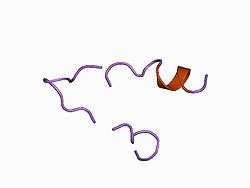Bicarbonate transporter protein
| HCO3- transporter family | |||||||||
|---|---|---|---|---|---|---|---|---|---|
 a low energy structure for the final cytoplasmic loop of band 3, nmr, minimized average structure | |||||||||
| Identifiers | |||||||||
| Symbol | HCO3_cotransp | ||||||||
| Pfam | PF00955 | ||||||||
| Pfam clan | CL0062 | ||||||||
| InterPro | IPR011531 | ||||||||
| PROSITE | PDOC00192 | ||||||||
| SCOP | 1btr | ||||||||
| SUPERFAMILY | 1btr | ||||||||
| TCDB | 2.A.31 | ||||||||
| |||||||||
| Band 3 cytoplasmic domain | |||||||||
|---|---|---|---|---|---|---|---|---|---|
 crystal structure of the cytoplasmic domain of human erythrocyte band-3 protein | |||||||||
| Identifiers | |||||||||
| Symbol | Band_3_cyto | ||||||||
| Pfam | PF07565 | ||||||||
| Pfam clan | CL0340 | ||||||||
| InterPro | IPR013769 | ||||||||
| SCOP | 1hyn | ||||||||
| SUPERFAMILY | 1hyn | ||||||||
| TCDB | 2.A.31 | ||||||||
| OPM superfamily | 336 | ||||||||
| OPM protein | 1btq | ||||||||
| |||||||||
In molecular biology, bicarbonate transporter proteins are proteins which transport bicarbonate. Bicarbonate (HCO3 −) transport mechanisms are the principal regulators of pH in animal cells. Such transport also plays a vital role in acid-base movements in the stomach, pancreas, intestine, kidney, reproductive organs and the central nervous system. Functional studies have suggested four different HCO3 − transport modes. Anion exchanger proteins exchange HCO3 − for Cl− in a reversible, electroneutral manner.[1] Na+/HCO3 − co-transport proteins mediate the coupled movement of Na+ and HCO3 − across plasma membranes, often in an electrogenic manner.[2] Na+ driven Cl−/HCO3 − exchange and K+/HCO3 − exchange activities have also been detected in certain cell types, although the molecular identities of the proteins responsible remain to be determined.
Sequence analysis of the two families of HCO3 − transporters that have been cloned to date (the anion exchangers and Na+/HCO3 − co-transporters) reveals that they are homologous. This is not entirely unexpected, given that they both transport HCO3 − and are inhibited by a class of pharmacological agents called disulphonic stilbenes.[3] They share around ~25-30% sequence identity, which is distributed along their entire sequence length, and have similar predicted membrane topologies, suggesting they have ~10 transmembrane (TM) domains.
A conserved domain is found at the C terminus of many bicarbonate transport proteins. It is also found in some plant proteins responsible for boron transport.[4] In these proteins it covers almost the entire length of the sequence.
The Band 3 anion exchange proteins that exchange bicarbonate are the most abundant polypeptide in the red blood cell membrane, comprising 25% of the total membrane protein. The cytoplasmic domain of band 3 functions primarily as an anchoring site for other membrane-associated proteins. Included among the protein ligands of this domain are ankyrin, protein 4.2, protein 4.1, glyceraldehyde-3-phosphate dehydrogenase (GAPDH), phosphofructokinase, aldolase, hemoglobin, hemichromes, and the protein tyrosine kinase (p72syk).[5]
References
- ↑ Kopito RR (1990). "Molecular biology of the anion exchanger gene family". Int. Rev. Cytol. 123: 177–99. doi:10.1016/S0074-7696(08)60674-9. PMID 2289848.
- ↑ Boron WF, Fong P, Hediger MA, Boulpaep EL, Romero MF (June 1997). "The electrogenic Na/HCO3 cotransporter". Wien. Klin. Wochenschr. 109 (12-13): 445–56. PMID 9261985.
- ↑ Burnham CE, Amlal H, Wang Z, Shull GE, Soleimani M (August 1997). "Cloning and functional expression of a human kidney Na+:HCO3- cotransporter". J. Biol. Chem. 272 (31): 19111–4. doi:10.1074/jbc.272.31.19111. PMID 9235899.
- ↑ Takano J, Noguchi K, Yasumori M, Kobayashi M, Gajdos Z, Miwa K, Hayashi H, Yoneyama T, Fujiwara T (November 2002). "Arabidopsis boron transporter for xylem loading". Nature. 420 (6913): 337–40. doi:10.1038/nature01139. PMID 12447444.
- ↑ Zhang, D.; Kiyatkin, A.; Bolin, J. T.; Low, P. S. (2000). "Crystallographic structure and functional interpretation of the cytoplasmic domain of erythrocyte membrane band 3". Blood. 96 (9): 2925–2933. PMID 11049968.
This article incorporates text from the public domain Pfam and InterPro IPR011531 This article incorporates text from the public domain Pfam and InterPro IPR013769